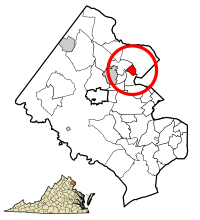Pimmit Hills, Virginia
| Pimmit Hills, Virginia | |
|---|---|
| Census-designated place (CDP) | |
 Location of Pimmit Hills in Fairfax County, Virginia |
|
| Location of Pimmit Hills in Fairfax County, Virginia | |
| Coordinates: 38°54′42″N 77°12′5″W / 38.91167°N 77.20139°WCoordinates: 38°54′42″N 77°12′5″W / 38.91167°N 77.20139°W | |
| Country | United States |
| State | Virginia |
| County | Fairfax |
| Area | |
| • Total | 1.5 sq mi (3.8 km2) |
| • Land | 1.5 sq mi (3.8 km2) |
| • Water | 0.0 sq mi (0.0 km2) |
| Elevation | 364 ft (111 m) |
| Population (2010) | |
| • Total | 6,094 |
| • Density | 4,100/sq mi (1,600/km2) |
| Time zone | Eastern (EST) (UTC-5) |
| • Summer (DST) | EDT (UTC-4) |
| FIPS code | 51-62264 |
| GNIS feature ID | 1496083 |
Pimmit Hills is a census-designated place (CDP) in Fairfax County, Virginia, United States. The population was 6,094 at the 2010 census. In practical terms, it is more of a neighborhood within a densely populated urban area than a traditional town.
It is found within the triangle made by the intersection of three highways: Interstate 495 (the Capital Beltway), Interstate 66, and State Route 267 (the Dulles Toll Road). Within this triangle, the actual bounds of the neighborhood are Pimmit Run, Leesburg Pike (State Route 7), and Magarity Road. Although Pimmit Hills is politically part of Fairfax County, Pimmit Hills addresses use Falls Church as their mailing address.
The area that is now Pimmit Hills was primarily farm land until the sub-division was built beginning in 1950. The houses in Pimmit Hills were mostly built during the 1950s for World War II and Korean War veterans and their families. Most of the houses were originally built as three bedroom, one bath dwellings of 833 square feet. Their initial price in 1950 was $9,950. George Offutt began construction of the first 500 Pimmit Hills houses in 1950. His Offutt Construction Company completed the first two sections by 1954. Other builders completed sections 3-6, while Offutt built sections 7 & 8 under a different company. The subdivision was fully built out by 1957-58, with 1675 homes on 663 acres. When the homes were first built, many areas were treeless, having been farm fields previously. However, decades later the area is known for its population of large oaks, Tulip trees and other trees.
...
Wikipedia



